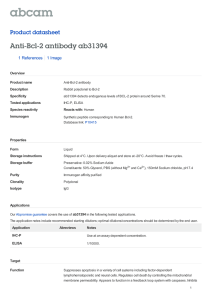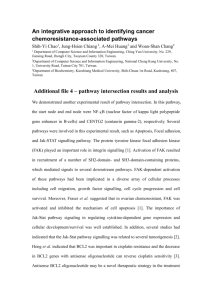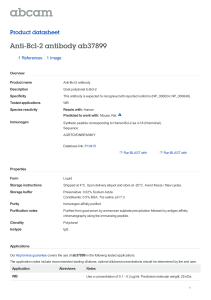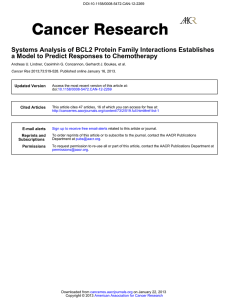Mechanisms of Programmed Cell Death and Neurotrophin Signaling Bob Freeman
advertisement
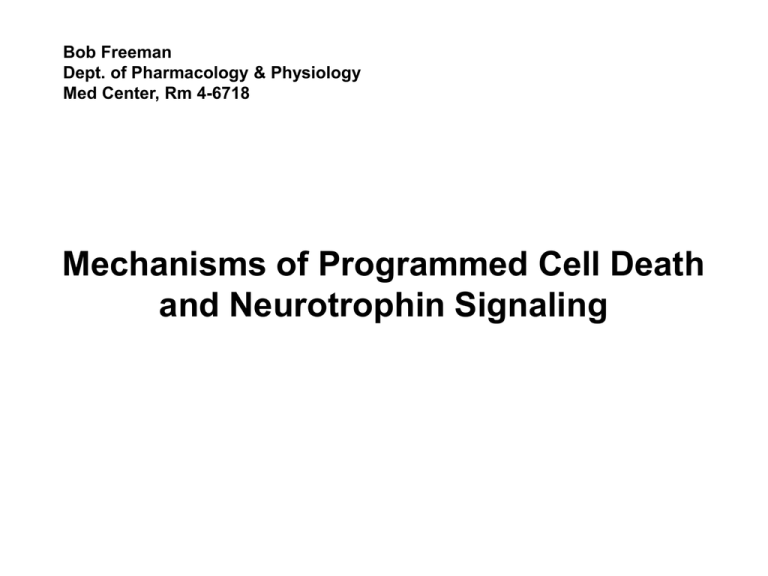
Bob Freeman Dept. of Pharmacology & Physiology Med Center, Rm 4-6718 Mechanisms of Programmed Cell Death and Neurotrophin Signaling Sources of neurotrophic support The Neurotrophic Factor Hypothesis neurotrophic factor receptor 1. Target tissues synthesize and release limited quantities of neurotrophic factors that bind and activate specific receptors on the termini of innervating neurons. 2. The neurotrophic factor and activated receptor are internalized and transported retrogradely back to the cell body where they exert trophic effects, including cell survival. Nerve Growth Factor: the prototype target-derived neurotrophic factor Nobel Prize in Physiology or Medicine - 1986 Stanley Cohen Dorsal root ganglion neurite outgrowth w/o NGF + NGF control Ab cell survival anti-NGF Ab anti-NGF Ab control Ab Sympathetic ganglia Rita LeviMontalcini Neurotrophic factor deprivation-induced cell death occurs by apoptosis Chromatin Fragmented DNA + NGF - NGF TUNEL = terminal deoxynucleotidyl transferase incorporation of dUTP by nick end-labeling Neurotrophic factor deprivation-induced death is a metabolically active process that requires de novo gene expression + NGF Withdraw NGF + Inhibitor of protein or RNA synthesis Martin et al., 1988 The genetics of programmed cell death was first described in the nematode C. elegans The genetics of programmed cell death was first described in the nematode C. elegans 1090 cells 959 cells generated during development of the hermaphrodite remain in the adult 131 cells die Phenotypes Extra cell deaths Mutagen screen progeny or Fewer cell deaths Functional relationship of cell death genes in C. elegans Three key cell death genes: ced-9 ced-4 ced-3 Cell death Tissue-specific commitment signals ced-9 Gene mutated Effect of mutation Cell death phenotype ced-9 ced-9 ced-4 ced-4 ced-3 ced-3 ced-9 / ced-4 ced-4 / ced-3 lof gof lof gof lof gof lof / lof gof / lof extra deaths no deaths no deaths extra deaths no deaths extra deaths no deaths no deaths lof = loss of function gof = gain of function ced-4 ced-3 The Nobel Prize in Physiology or Medicine 2002 The Nobel Prize in Physiology or Medicine 2002 Cell death Clearance and degradation Sydney Brenner Sydney Brenner H. Robert Horvitz H. Robert Horvitz John E. Sulston John E. Sulston Cell death mechanisms have been conserved through evolution BH3-only BAX Members of the ‘BCL2 family’ of proteins General Scheme for Apoptosis Neurotrophic factor deprivation Widespread proteolysis Growth factor/cytokine deprivation Activation of death receptors Physiologic, toxic, or pathologic cell death stimulus DNA fragmentation BAX + - Activation of caspases Cell death Dismantling of the cytoskeleton BCL2 Cytopathic viruses Oxidative stress Membrane blebbing Radiation Chemotherapy drugs apoptotic stimulus signal transduction execution destruction Caspases are essential for normal brain development wild type caspase-9 knockout Caspases: Pro-apoptotic cysteine proteases Activation requires cleavage of inactive ‘procaspases’ into large and small subunits that then self-assemble into active enzyme. Procaspase (inactive precursor) Active caspase sites of cleavage catalytic sites ‘pro’ domain C. elegans CED-3 large small Conversion of procaspases to active caspases requires caspase activity Initiator caspase Effector caspase Initiator activation Inactive monomer Forced dimerization and self-cleavage Apoptotic stimulus Effector activation Active initiator caspase Inactive effector caspases Active effector caspase The intrinsic apoptosis pathway: Cytoplasmic cytochrome c stimulates the recruitment and activation of initiator caspases NGF withdrawal Mitochondrion Mitochondrial outer membrane permeabilization Cytochrome c APAF-1 Procaspase-9 ‘Apoptosome’ + - BCL2 family proteins BCL2 family proteins include pro-survival and pro-apoptotic members Pro-survival BCL2 family BCL2, BCLX, BCLW, MCL1 Pro-apoptosis BAX family BAX, BAK, BOK BH3-only family BID BIM, BAD, BMF, HRK NOXA, PUMA Pro-apoptotic BCL2 family proteins promote mitochondrial outer membrane permeabilization (MOMP) and release of cytochrome c Mitochondria outer membrane IMS = Mitochondria intra-membrane space Dual function of BH3-only proteins: (1) bind and inhibit pro-survival BCL2 proteins; (2) bind and activate pro-apoptotic BCL2 proteins (BAD, HRK, NOXA) Sensitization BCL2 etc. BH3-only (BIM, BID, PUMA) Pro-survival Activation BAX, BAK Pro-apoptosis Interactions between the different types of BCL2 family proteins regulate the intrinsic cell death pathway BH3-only Neurotrophin deprivation cytochrome c BH3-only Neurotrophin addition Neurotrophins: A family of neurotrophic factors characterized by similar amino acid sequence and tertiary structure and derived from a common ancestral gene. NGF BDNF NT-3 NT-4 - nerve growth factor brain-derived neurotrophic factor neurotrophin-3 neurotrophin-4 N-Glyc SIGNAL SEQUENCE K/R C 18-24 AA 60-120 AA proneurotrophin neurotrophin SS S SS C C C CC PRO-SEQUENCE preproneurotrophin S MATURE PROTEIN neurotrophin homodimer ~ 120 AA 50% AMINO ACID IDENTITY pI 9-10 Neurotrophin Receptors Two classes of neurotrophin receptors: low affinity (Kd = 10-9 M) & high affinity (Kd = 10-11 M) TRK Transmembrane tyrosine kinase receptor. Ligand binding stimulates the intrinsic protein kinase activity of its intracellular domain. Three TRK genes (TRKA, TRKB, TRKC) encode closely related receptors that bind to distinct neurotrophins. Required, but not sufficient, for high affinity binding of neurotrophins. p75NTR Short intracellular domain contains a protein interaction domain. Binding to neurotrophin alters the conformation of the receptor in a way that creates new binding sites for several cytoplasmic proteins. Binds all mature neurotrophins with similar affinities. Binds to proneurotrophins with even greater affinity. Also binds several other proteins. Activation can promote cell survival, growth cone repulsion, or even apoptosis depending on the specific ligand and co-receptor present. Required, but not sufficient, for high affinity binding. Neurotrophin Specificity NGF BDNF, NT4 NT3 NGF, BDNF NT3, NT4 Tyrosine kinase domain TRKA TRKB TRKC p75NTR High affinity neurotrophin receptor complex Basic NGF signaling pathways Synaptic plasticity Survival Differentiation, Neurite growth, Plasticity Survival Apoptosis Neurotrophins, acting through Trk/p75 receptors, inhibit cell death via effects on BCL2 family proteins caspase activation and cell death cytochrome c release Mitochondrion Neurotrophins (1) Increase the expression of prosurvival BCL2 family genes (2) Bcl-2 Inhibit transcription of BH3-only genes (4) Block translocation of pro-apoptotic BCL2 proteins to the mitochondria BH3 only (3) Promote degradation of BH3-only proteins NGF + TrkA/p75NTR RAS PI3K active P BAD BIM BAX BAD BCL2 AKT inactive MAPK BAX active P P BIM P BCL2 P BIM mitochondrion FOXO p53 JUN NFκB CREB MYC AAAAAA AAAAAA BH3-only mRNA expression AAAAAA BCL2 mRNA expression
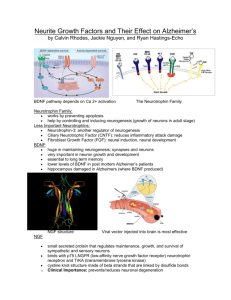
![Anti-Bcl-2 antibody [Bcl2/100] ab117115 Product datasheet 1 Abreviews Overview](http://s2.studylib.net/store/data/013113520_1-e21e3f6ec0d3fe253dc2df5ea8627718-300x300.png)
![Anti-Bcl2 alpha antibody [8C8] (Biotin) ab79204 Product datasheet 1 References Overview](http://s2.studylib.net/store/data/011980425_1-774aa8df902186d77a9b50da937191bb-300x300.png)
